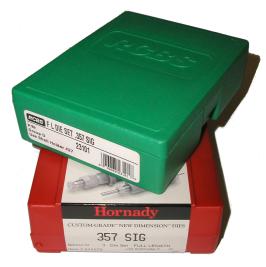
Generally speaking, I think most of us tend to get familiar with one brand of reloading die when we start out reloading, and stay with that brand unless we encounter some serious problem with the product in use. Each brand has some feature designed to set it apart from competitors, but I’ve come to think of most of these product differences as finesse, rather than material; nothing major, just a minor tweak or two of a relatively standard product. In the case of 357 SIG die sets, I thought there might be something more. Hornady, Lee, Redding and RCBS dies are designed to roll crimp rather than taper crimp. Hornady and Redding does offer a taper crimp seating die as an option. All relatively odd as the case spec is to headspace on the case mouth, which means no roll crimp, and there are few 9mm bullets suitable for this specific application that have a cannelure.
Further differences; RCBS offers a two die set, all others offer three die sets, the latter more traditional for a pistol. The 357 SIG is a bottle necked cartridge, so a two die set actually seems to make more sense, however, problems relating to sizing and bullet seating I encountered during a recent project could make a case for a three die set. In any event, I had a pretty good excuse for buying a set of Hornady New Dimension Dies, with a potential to purchase a Hornady press. Since RCBS dies are generally available for $25 for the 357 SIG. and Hornady New Dimension run $50, I wanted to make sure I knew what was doubling the price of a set of dies.
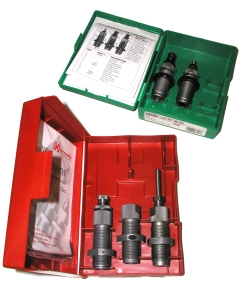
From the standpoint of product support, both companies are very similar, die sets carry a life time warranty against defects in workmanship or material. I am not familiar with Hornady’s processing of warranty claims, but I’ve heard they are very similar to RCBS; no questions asked, they replace anything that breaks. I know I’ve called RCBS to order replacement decapping rods or pins, explaining I abused the equipment and caused the failure, and they still replaced the parts at no charge.
RCBS offers a range of seating plugs for various bullet contours, which is nice. I have three for the 357 SIG and I tend to change out for various bullet profiles. Hornady’s three die pistol sets normally incorporate a long wearing titanium-coated sizing ring as an alternative to carbide inserts, however, this does not carry over to the bottle neck 357 SIG cartridge. This basically means 357 SIG cased need to be lubed when they are sized.

The sizing dies are good indications of the companies differing approach to tooling. Hornady built their 357 SIG tooling like a straight wall pistol die set, which would initially appear to be more cost effective.
Number 1 & 2 assemblies, for both products, constitute the decapping rod and pin assemblies. RCBS utilizes a threaded shaft, and adjusting nut and lock nut to locate the rod in the die, then an expander ball that is pulled back though the case neck after sizing to set the proper case neck inside diameter, and a replaceable pin that is used to punch out the spent primer as part of the case sizing operation – a lot of expensive multi machine step parts.
Hornady uses a collet to locate the decapping rod, 1 & 2, there are no threading or step turning operations, and the decapping pin is an integral part of the decapping rod. However, because there is no expander ball to open the case neck after sizing, Hornady must use a separate die (lower 3) as an additional step to fully form the case and prep it for bullet seating.
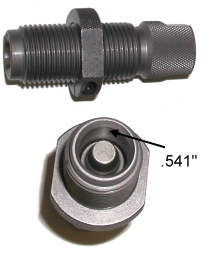 In the RCBS setup, the expander ball is fed into the case through the fired cartridge’s oversized case neck, the body of the die sizes to reduce the neck diameter, and the ball is pulled back through the case neck as the press pulls the case from the die. This means the final force applied to the case is to pull upward against the support of the die, not downward against unsupported case shoulders.
In the RCBS setup, the expander ball is fed into the case through the fired cartridge’s oversized case neck, the body of the die sizes to reduce the neck diameter, and the ball is pulled back through the case neck as the press pulls the case from the die. This means the final force applied to the case is to pull upward against the support of the die, not downward against unsupported case shoulders.
Hornady full length sizes with the first pass of the sizing die, however, there is no expander ball to pull back through the case neck to set the proper neck inside diameter. In a second operation, the case is pressed into an expander die, pictured right, that forces a plug with a tapered lead down into the case to set the correct neck diameter. With a .541″ inside die diameter, and a case diameter of .424″ there is no real lateral support for the case shoulders or body.

RCBS (top) and Hornady seating dies are quite different. RCBS employs a machined die body that crimp forms and supports the case neck when pressing a bullet into the case. The plug used to force the bullet down into the case is a simple threaded plug with an adjusting/lock nut set up. As I mentioned earlier, RCBS produces plugs in a variety of tip contours to insure conformity with the bullet type in use.
Again, I can’t tell if Hornady is motivated by cost reduction, quality of assembly, or both, in the approach they take to their seating die design. The die body appears to be universal in application, nothing more than a straight wall inside, .628″ inside diameter; an Ultra Mag Case is only .550″ at its greatest diameter. Even the .378 Weatherby case would fit at .582″, so this makes for a lot of common inventory, few setups for production, and long automated machine runs. I am not suggesting in any way this is a poorly made assembly, it obviously is of excellent quality, it may just be a smarter design.
The guts of the die, all labeled “1”, from bottom to top – The bullet alignment sleeve carries the more precise machine work, and provides bullet alignment and supports the case neck while seating. The Hornady neck support diameter is .381″, the RCBS die interior at the same point is .383″. The nominal 357 SIG case spec is .381″. The seating stem, middle, is the anvil that presses the bullet into the case. The seater adjustment screw, top, is adjusted to achieve the correct seating depth.
The seating stem and bullet alignment sleeve float, Hornady calls this a floating in-line sleeve design, and it is actually pretty neat. Gravity causes the sleeve assembly to drop down to the bottom of the die when the press ram is in the down position, so as a bullet and case are started into the die, they are engaged and aligned much earlier on in the press stroke than they would be with a fixed seating plug die. And the best part is, the floating in-line sleeve won’t fall out and roll under the bench, because it is retained by the small spring clip labeled “2”….no, not the big part labeled “2”, the small wire loop.
The die sets in use
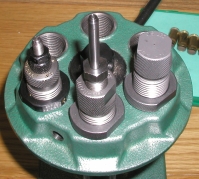
The RCBS Turret Press didn’t seem to mind the Hornady dies and the shell holder caused no dimensional problems in case sizing. The Hornady die is a little different in that it is installed with the ram in the up position, and screwed in until it just makes contact with the shell holder, unlike the RCBS die which is set to touch the shell holder, then the ram is dropped and the die is tightened another quarter turn or so, to cause the die cam over against the shell holder. The RCBS Turret press die holes are not large enough to accept Lock-N-Load bushings, but it does handle all standard 7/8″x14 threaded dies. The early model RCBS Rock Chucker presses have 1 1/4″ x 12 die opening that utilizes a bushing to convert it to 7/8″x14 threads. The bushing can be removed and fitted with a Hornady Lock-N-Load adapter, so the RCBS press can work with the Hornady die quick change set up. The expander die, far right, is set by trial and error until a very slight “bell” forms at the case mouth, emphasis on “very slight”. The flats on the Hornady dies work for me, it’s convenient to be able to remove and tighten dies with a 3/4″ wrench.
For the sake of comparison
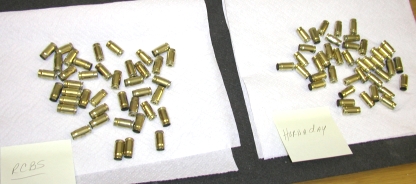
I knocked out primers from once fired cases with a RCBS universal decapping die, prepped the brass, made two equal piles, then sized half in the RCBS die, and the other half in the two step Hornady process. All and all, a pretty boring routine task, regardless the die set, required sizing effort was about the same.
I pulled samples of sized brass for measurement. Brass passing through the Hornady setup was measured twice, once before, and once after the expander die operation. I was concerned the downward force of the expander die, on the fragile bottle neck case with no should support, would cause the shoulders to buckle or balloon. This was uniformly not the case, as here were no signs of distortion of any type, just cleanly formed cases, all very close in measurement to the RCBS cases.
 To maintain an overall cartridge length of 1.140″, and use a roll crimp, I needed to place the cannelure forward on the bullet shank, just about at the transition to the ogive. It is hard to tell from the picture, but the depth of the cannelure is approximately .015″ at the most shallow point. The brass thickness at the case mouth is only .011″~.012″ so the depth is sufficient.
To maintain an overall cartridge length of 1.140″, and use a roll crimp, I needed to place the cannelure forward on the bullet shank, just about at the transition to the ogive. It is hard to tell from the picture, but the depth of the cannelure is approximately .015″ at the most shallow point. The brass thickness at the case mouth is only .011″~.012″ so the depth is sufficient.
Average case dimensions – random sample of 20 each
| 357 SIG Case | Point | SAAMI Spec |
Fired Brass |
Sized Case | No Crimp | Roll Crimp 2 | |||
| RCBS | Hornady1 | RCBS | Hornady | RCBS | Hornady | ||||
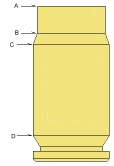 |
A | .3810 | .3850 | .3765 | .3830 | .3780 | .3800 | .3780 | .3780 |
| B | .3810 | .3880 | .3765 | .3770 | .3795 | .3780 | .3780 | .3795 | |
| C | .4240 | .4260 | .4200 | .4200 | .4195 | .4190 | .4200 | .4200 | |
| D | .4240 | .4260 | .4220 | .4225 | .4225 | .4225 | .4225 | .4225 | |
|
Note: 1) Includes flare from expander 2) SIG will not chamber reliably above .4280″ C dimension |
|||||||||
Judging by the measurements taken, there would seem to be no significant difference in output quality from either dies set, leaving choice of box color and trivial design differences as the bases for choice. However….
An issue of concentricity
RCBS Hornady
No Crimp .0020″ max .0015″ avg. .0040″ max .0030″ avg.
Crimp .0040″ max .0025″ avg. .0050″ max .0045″ avg.
In all fairness, because the roll crimps were made into bullets I modified with a cannelure, I would not be quick to suggest Hornady dies produces ammo that is always non-concentric by .0050″, but in looking at the non-crimped ammo, concentricity number where no cannelures were cut, I would suggest that RCBS dies produced ammo with half the run out of Hornady production when using unaltered components.
Ease of Use and Adjustment
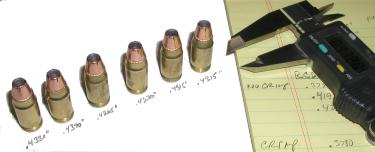
I trimmed all of the cases to equal length prior to attempting roll crimps, as is the typical requirement. Still, the Hornady die set was more prone to collapsing case shoulders than the RCBS die set. An eighth turn in adjustment of the Hornady set made the difference between a very moderate roll crimp, and damaged brass.
RCBS or Hornady Dies ?
My preference is for the two die RCBS set; one less die operation, and I believe more stability in the bullet seating step where there are fewer moving parts to align. I also believe the sizing ball and lack of flaring of the case mouth yields more consistent sizing results and doesn’t overwork the brass unnecessarily. I think most of the Hornady innovation is directed at cost reduction rather than improved quality of ammo; the one piece decapping assembly, the universal sizing die, the use of plugs and sleeves to adapt seating dies to a variety of cartridges, etc. Finally, I believe a three die set for a bottle neck cartridge is unnecessary. If the case isn’t straight walled, and there are many rifle cartridges above .355″ bullet diameter sized with a sizing ball, what would be the reason for the Hornady three die approach? Would I dump a set of Hornady dies and replace them with RCBS? No, not at all, but If I had worn Hornady dies, I might consider replacing them with something else. Perhaps I will try other Hornady dies sets other than the 357 SIG, maybe one of their match sets.
No roll crimps for now from either die set. I can make them cartridges relatively easily, and there is a definite performance boost when they are applied. The problem is a couple of percentage points of failure to feed is not OK for this gun and application. I’m not done yet, I thought of another solution, and I am waiting to hear back from a couple of suppliers before I will know if the approach is realistic.
Miscellaneous Powder Handling Information
 During the course of putting the preceding information together I encountered a few other items that might be of interest.
During the course of putting the preceding information together I encountered a few other items that might be of interest.
I’m very old, consequently, I sometimes fall asleep while waiting for powder to pass though a powder funnel and back into a powder canister. Hoppy makes a radiator funnel that is perfect for this purpose and, better yet, it is cheap – about $2.00.
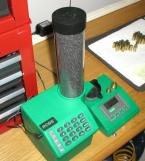
Since I was going to charge a decent number of cases with the same powder type and weight, I thought I’d drag out the RCBS Powder Master Electronic Dispenser and Powder Pro Scale for another try out. Setup took a couple of minutes, self calibration took about 10 minutes, and then it proceeded to knock out a string of charges that rarely varied by one tenth of a grain. Unfortunately, 20 second per measuring cycle is just too much time to waste, even for a slow poke like me. I suspect what the measure needs is a better algorithm for the coarse feed to reduce gross metering time, and finesse meter with the fine feed. As it is, both coarse and fine sort of just dribble. At 5 or 10 seconds per cycle, we’d have a winner and I’d use the Powder Master routinely.
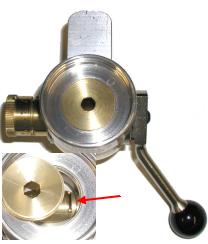
Not without other reloading toys, I immediately went for my Harrell’s Precision Premium Powder Measure with it’s dispensing range of 6 – 120 grains. Why is it a “premium” measure? $230 for the measure, plus $40 for the stand so the measure doesn’t just lay on its side on the bench and look dumb.
Below about 10 grain or so, this model Harrell is not useful. Attempting 7.6 grains yielded charges from 3 grains to 10 grains across 10 stokes of the handle. If you pull up the brass baffle at the bottom, and check out the measuring chamber (arrow) when it approximates 7 or 8 grains of volume, you’ll see there is little room for powder mass between the baffle and chamber to assure gravity feed and uniform filling. I remain convinced the Harrell Measure is a collection of beautifully machined parts, but not necessarily unified in mission.
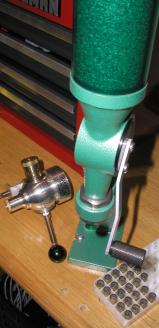
So with my RCBS Mixmaster back in the cabinet, my Harrell Precision Measure looking…shiny, I dragged my RCBS measure away from it’s post under my Harley windshield bracket set and battery charger, set it to 7.6 grain in about 3 adjustment cycles, and ran off 100 more charges that were 7.6 -.2/+0. Not bad for about $50. I have a similar Lock-N-Load Hornady measure, with increased capacity kit installed, that does about the same.
I do have a design for what I feel would be a very accurate and flexible measure. If I can ever get my hands on some silly putty, powdered moly, a digital bathroom scale, and a length of black gas pipe…and I get settled into my new work area in Maine, I may attempt to produce such an item.
I’m done with the SIG for a while. My pet load for now is:
Hornady 147 Grain HP/XTP #35580
Alliant Power Pistol 7.6 grains
CCI 500 Small Pistol Primer
No Crimp
Avg. MV 1280 fps
Thanks
Joe

Email Notification